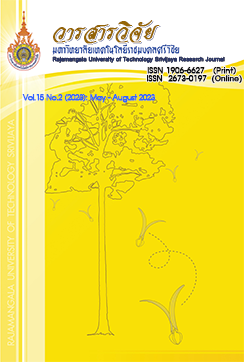The Study of Thickness Ratio and Bamboo Fiber and Recycled-Polypropylene Core Layer on Acoustic and Mechanical Properties of Sandwich Composites
Keywords:
sandwich structure, wood plastic composites, bamboo fiber, recycled polypropylene, acoustic propertyAbstract
The construction materials mostly focus on overall mechanical properties. One of pollutions often found is the noise pollution. For this reason, the sandwich structure is the source of solution for this kind of problem. This structure can add various insulation for different properties into the sandwich composites. This study focuses on the material of the core layer and the thickness ratio between the face sheet and the core layers of the sandwich structure. Therefore, the objective of this research is to study the behaviors of the core material and the thickness ratio between face sheet layer and core layer that influence both an acoustic and mechanical properties. The raw materials for the core layer include bamboo fiber and recycled polypropylene (rPP) with three different thickness ratios for the face sheet and the core layers namely 2-6-2, 3-4-3, and 4-2-4 mm. The results revealed that the sandwich structure, compared to the wood plastic composites (WPCs), had a significant influence on the increase of noise reduction coefficient and hardness values whereas the flexural strength and compressive strength decreased significantly. Additionally, increasing thickness ratio from 4-2-4 to 2-6-2 mm had an influence on the increase of noise reduction coefficient and flexural and hardness values whereas the compressive value decreased significantly. Furthermore, the bamboo fiber as a core layer significantly provided higher noise reduction value than that of rPP. On the other hand, the rPP gave significantly higher overall mechanical properties than that of bamboo fibers as a core layer.
References
Abdallah, T. 2017. Environmental Impacts, pp. 45-59. In Abdallah T., ed. Sustainable Mass Transit. Elsevier, United State.
Afolabi, L.O., Ariff, Z.M., Hashim, S.F.S., Alomayri, T., Mahzan, S., Kamarudin, K.A. and Muhammad, I.D. 2020. Syntactic Foams Formulations, Production Techniques, and Industry Applications: A Review. Journal of Materials Research and Technology 9(5): 10698-10718.
Air Quality &. Noise. Management Division. 2020. Situation and Management of Air Pollution and Noise Problems in 2 20. Department Pollution Control. Available Source: Thailand https://www.pcd.go.th/publication/14100, April 3, 2022. (in Thai).
ALRahman, L.A., Raja, R.I. and Rahman, R.A. 2013. Experimental Study on Natural Fibers for Green Acoustic Absorption Materials. American Journal of Applied Sciences 10(10): 1307-1314.
Anisuzzaman, S.M., Bono, A., Krishnaiah, D., Ismail, N.M. and Mansuit, H. 2014. The Performance of Melamine Urea Formaldehyde (MUF) Based Particleboard with Wheat Flour as Filler. Jurnal Teknologi (Sciences and Engineering) 68(1): 61-69.
Chin, D.D.V.S., Yahya, M.N.B., Che Din, N.B. and Ong, P. 2018. Acoustic properties of biodegradable composite micro-perforated panel (BC-MPP) made from kenaf fibre and polylactic acid (PLA). Applied Acoustics 138: 179-187.
Dalai, N. and Sreekanth, P.S.R. 2021. UHMWPE / Nanodiamond Nanocomposites for Orthopaedic Applications: A Novel Sandwich Configuration Based Approach. Journal of the Mechanical Behavior of Biomedical Materials 116: 104327.
Hussain, C.H. and Keçili, R. 2020. Environmental pollution and environmental analysis, pp. 1-36. In Hussain, C. and Keçili, R., eds. Modern Environmental Analysis Techniques for Pollutants. Elsevier, United State.
National Statistical Office. 2017. Data Processing of Construction Areas. 2017. National Statistical Office (Thailand). Available Source: http://www.nso.go.th/sites/2014/Pages/News/2561/N24-04-61-1.aspx, February 11, 2022. (in Thai)
Homkhiew, C., Ratanawilai, T. and Thongruang, W. 2014. The Optimal Formulation of Recycled Polypropylene/Rubberwood Flour Composites from Experiments with Mixture Design. Composites Part B: Engineering 56: 350-57.
Lee, J.H., Kang, S.H., Ha, Y.J. and Hong, S.G. 2018. Structural Behavior of Durable Composite Sandwich Panels with High Performance Expanded Polystyrene Concrete. International Journal of Concrete Structures and Materials 12(1): DOI 10.1186/s40069-018-0255-6.
Or, K.H., Putra, A. and Selamat, M.Z. 2017. Oil Palm Empty Fruit Bunch Fibres as Sustainable Acoustic Absorber. Applied Acoustics 119: 9-16.
Papanikolaou, G. and Trochides, A. 1985. Design of a Test Facility for Transmission Loss Measurement. Applied Acoustics 18(5): 315-323.
Patel, J.M. and Modi, B.A. 2013. Stiffness and Thermal Analysis of Doubly Curve Sandwich Panel for an Automobile Application. Procedia Engineering 51: 655-664.
Peng, L. 2017. Sound absorption and insulation functional composites, pp. 333-373. In Fan, M. and Fu, F., eds. Advanced High Strength Natural Fibre Composites in Construction. Woodhead Publishing, Singapore.
Promjan, J., Ratanawilai, T. and Homkhiew, C. 2021. The Property of Sandwich-Structure Rubberwood-Plastic Composites with Different Plastic Core Layer. The Journal of King Mongkut’s University of Technology North Bangkok 32(3): 700-711. (inThai)
Putra, A., Or, K.H., Selamat, M.Z., Nor, M.J.M., Hassan, M.H. and Prasetiyo, I. 2018. Sound Absorption of Extracted Pineapple-Leaf Fibres. Applied Acoustics 136: 9-15.
Putra, A., Khair, F.A. and Nor, M.J.M. 2015. Utilizing Hollow-Structured Bamboo as Natural Sound Absorber. Archives of Acoustics 40(4): 601-608.
Singh, Z. and Bhalla, S. 2017. Advance Research in Textile Engineering Toxicity of Synthetic Fibres & Health. Advance Reserach in Textile Engineering 2(1): 1-4.
Styles, M., Compston, P. and Kalyanasundaram, S. 2007. The Effect of Core Thickness on the Flexural Behaviour of Aluminium Foam Sandwich Structures. Composite Structures 80(4): 532-538.
Downloads
Published
How to Cite
Issue
Section
License
Copyright (c) 2023 Rajamangala University of Technology Srivijaya Research Journal

This work is licensed under a Creative Commons Attribution-NonCommercial-NoDerivatives 4.0 International License.
The content and information in the article published in Journal of Rajamangala University of Technology Srivijaya It is the opinion and responsibility of the author of the article. The editorial journals do not need to agree. Or share any responsibility.







